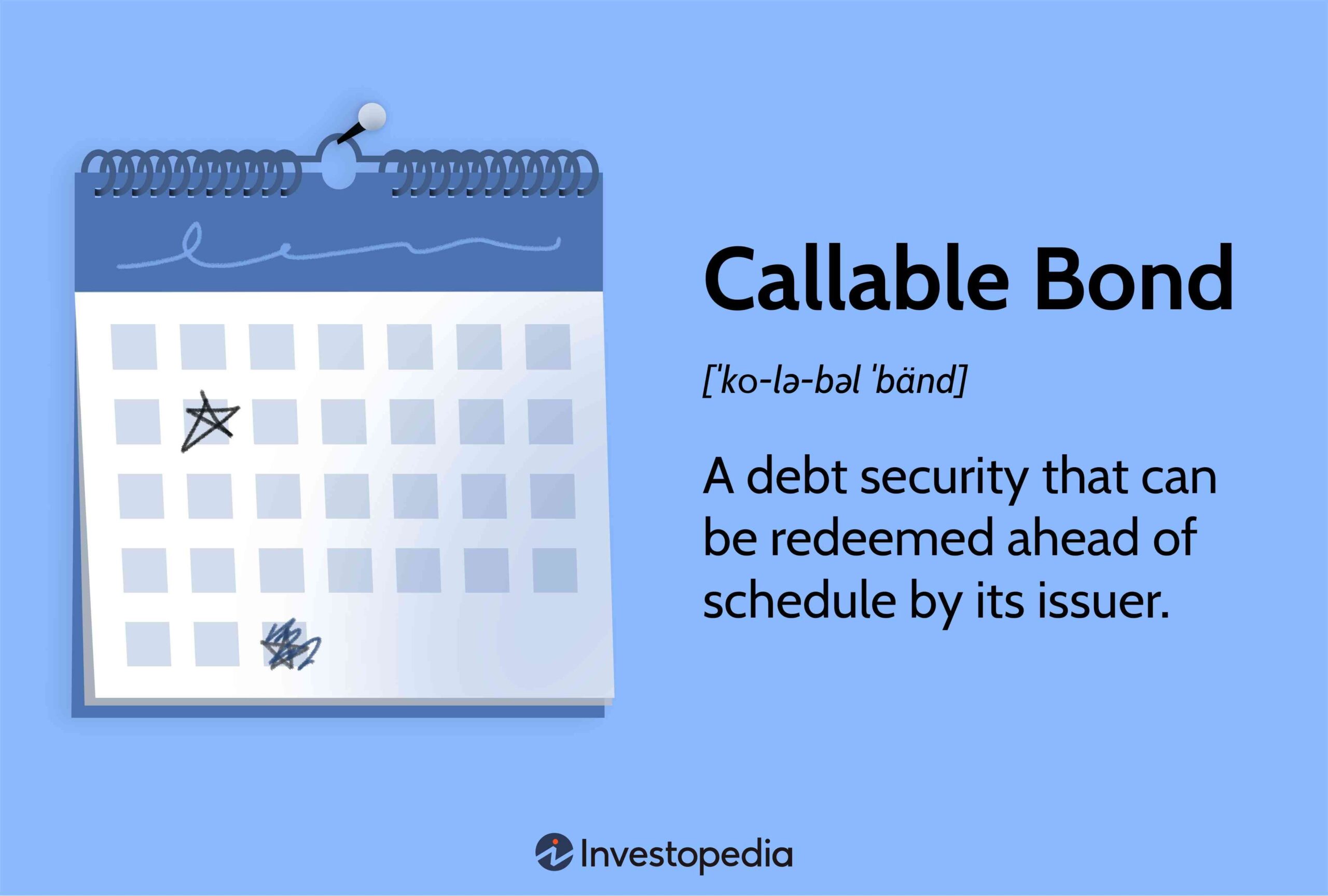A callable bond in investments is a type of bond that gives the issuer the option to redeem or “call” the bond before its maturity date. This means that the issuer can repay the bond’s principal and stop making interest payments to bondholders. While callable bonds offer flexibility to issuers, they can pose risks to investors. In this article, we will delve into what a callable bond is, how it works, and the implications it has for both issuers and investors. So, whether you’re new to the world of bonds or looking to expand your investment knowledge, keep reading to gain a deeper understanding of callable bonds in investments.
What is a Callable Bond in Investments?
A callable bond is a type of bond that gives the issuer the right to redeem or call back the bond before its maturity date. In other words, the issuer has the option to buy back the bond from the bondholder at a predetermined price, usually at a slight premium to the face value of the bond. This feature provides flexibility to the issuer, but it can also affect the investor’s returns and introduce certain risks.
Callable bonds are commonly issued by corporations, government entities, and municipalities to raise capital. They are an attractive financing option for issuers because they allow them to take advantage of lower interest rates if market conditions become favorable. However, from an investor’s perspective, callable bonds can be both advantageous and disadvantageous, depending on the prevailing interest rates and the specific terms of the bond.
How Callable Bonds Work
Callable bonds have a call provision embedded in their terms. This provision stipulates the conditions under which the issuer can call back the bond. The call provision includes the call price, call date, call premium, and any specific conditions or restrictions.
When the issuer decides to call a bond, they typically pay the bondholder the face value of the bond plus a predetermined call premium. This call premium, also known as the call price or call premium price, compensates the bondholder for the loss of future interest payments if the bond is called before its maturity date.
For example, let’s say an investor holds a callable bond with a face value of $1,000 and a call premium of 2%. If the issuer decides to call the bond, they would be required to pay the investor $1,020 ($1,000 face value + $20 call premium). This compensates the investor for the lost interest payments they would have received had the bond remained outstanding until maturity.
Advantages of Callable Bonds for Investors
Callable bonds can offer certain advantages to investors, including:
- Higher yields: Callable bonds often offer higher yields than non-callable bonds to compensate investors for the risk of early redemption. This can be attractive to income-seeking investors.
- Opportunity for capital gains: If interest rates decline after the issuance of a callable bond, the issuer may be motivated to call and reissue the bond at a lower interest rate. This creates an opportunity for investors to benefit from capital gains.
- Flexibility: Callable bonds provide investors with the flexibility to reinvest their funds in a more favorable investment if the bond is called. This allows investors to take advantage of better investment opportunities or higher interest rates.
Risks of Callable Bonds for Investors
While callable bonds offer benefits, they also carry certain risks that investors should be aware of:
- Early redemption risk: The main risk for bondholders is the potential for the issuer to call the bond before its maturity date. This can limit the bondholder’s potential to earn interest for the full term of the bond, especially if interest rates decline after the bond is issued.
- Reinvestment risk: If a callable bond is called, the investor may need to reinvest the proceeds at a lower interest rate, which can result in lower overall returns.
- Uncertainty: It can be difficult for investors to predict if and when a callable bond will be called. This uncertainty can make it challenging to plan investment strategies around callable bonds.
Factors Affecting the Likelihood of Bond Calls
Several factors influence the likelihood of a bond being called, including:
Interest Rates
Interest rates play a crucial role in determining whether a bond will be called. When interest rates decline, issuers are more likely to call existing bonds and issue new ones at a lower rate. On the other hand, when interest rates rise, the issuer is less likely to call the bond since they would have to issue new bonds at higher rates.
Call Protection Period
Some callable bonds have a call protection period during which the issuer is prohibited from calling the bond. This period provides some certainty to investors regarding the minimum amount of time they can expect to hold the bond without it being called.
Creditworthiness of the Issuer
The creditworthiness of the issuer can influence the likelihood of a bond being called. If the issuer’s creditworthiness improves, they may be able to refinance the bond at a lower rate, increasing the chances of a call. Conversely, if the issuer’s creditworthiness deteriorates, they may be unable to issue new bonds, reducing the risk of a call.
Callable Bonds vs. Non-Callable Bonds
Callable bonds differ from non-callable bonds in terms of their potential for early redemption. Non-callable bonds, also known as bullet bonds, cannot be redeemed by the issuer before their maturity date. This means that bondholders can rely on receiving interest payments for the full term of the bond.
Non-callable bonds tend to have slightly lower yields compared to callable bonds due to the absence of call risk. However, they provide more certainty to investors regarding interest income and the duration of their investment.
Callable bonds provide issuers with flexibility and the ability to take advantage of favorable market conditions. At the same time, they introduce risks and uncertainties for investors, such as early redemption and reinvestment risk. Understanding the terms and conditions of callable bonds is crucial for investors to make informed decisions and manage their portfolio effectively. By considering the factors that influence the likelihood of a bond being called, investors can assess the potential risks and rewards associated with these types of investments.
Callable Bond Explained – Definition, Benefits & Risks
Frequently Asked Questions
Frequently Asked Questions (FAQs)
What is a callable bond in investments?
A callable bond is a type of bond that gives the issuer the right to redeem or “call” the bond before its maturity date. This means that the issuer can repay the bond’s principal and stop making interest payments to the bondholder.
How does a callable bond work?
When a bond is issued, it typically has a set maturity date, which is when the issuer is obligated to repay the bondholder the principal amount. However, with a callable bond, the issuer has the option to repay the bond early, usually after a certain period of time, at a specified call price.
Why do issuers choose to issue callable bonds?
Issuers may choose to issue callable bonds because it gives them the flexibility to take advantage of changes in interest rates. If interest rates decline, the issuer can call the bond and issue new bonds at a lower interest rate, reducing their borrowing costs.
What are the advantages of investing in callable bonds?
Investing in callable bonds can provide higher yields compared to non-callable bonds, as compensation for the risk of early redemption. Callable bonds also offer the potential for capital gains if interest rates fall, as the issuer may call the bond and investors can then reinvest at lower rates.
What are the risks of investing in callable bonds?
One of the main risks of investing in callable bonds is the possibility of early redemption. If interest rates decline, the issuer may choose to call the bond, leaving the investor with the reinvestment risk of finding another investment with similar returns. Additionally, callable bonds may have less upside potential if interest rates fall, as the bond’s price may be limited by the call price.
How are callable bonds priced?
Callable bonds are typically priced using a yield-to-call calculation, which takes into account the bond’s call date, call price, and coupon payments. The yield-to-call represents the total return an investor would receive if the bond is called at the earliest opportunity.
Can callable bonds be called at any time?
Callable bonds can only be called by the issuer after a specified call protection period. This period, usually several years from the bond’s issuance, provides investors with some assurance that the bond won’t be called immediately after purchase.
Are callable bonds suitable for all investors?
Callable bonds are generally considered more suitable for experienced investors who have a good understanding of the risks involved. These bonds require careful evaluation of the call protection period, call price, and potential reinvestment options. It’s important to assess whether the higher yield compensates for the risk of early redemption.
What is the difference between a callable bond and a non-callable bond?
The main difference between a callable bond and a non-callable bond lies in the issuer’s ability to redeem the bond before maturity. A non-callable bond cannot be redeemed by the issuer until the set maturity date, while a callable bond gives the issuer the right to call the bond early under certain conditions.
Final Thoughts
A callable bond in investments refers to a type of bond that can be redeemed or “called” by the issuer before its maturity date. This feature gives the issuer the ability to take advantage of favorable market conditions by refinancing the bond at a lower interest rate. However, callable bonds pose a risk to investors, as they may face the possibility of having their bond called back, resulting in the return of their principal earlier than expected. It is important for investors to carefully consider the terms and conditions of callable bonds before investing in them. Understanding what a callable bond is in investments helps investors make informed decisions and manage their portfolios effectively.



